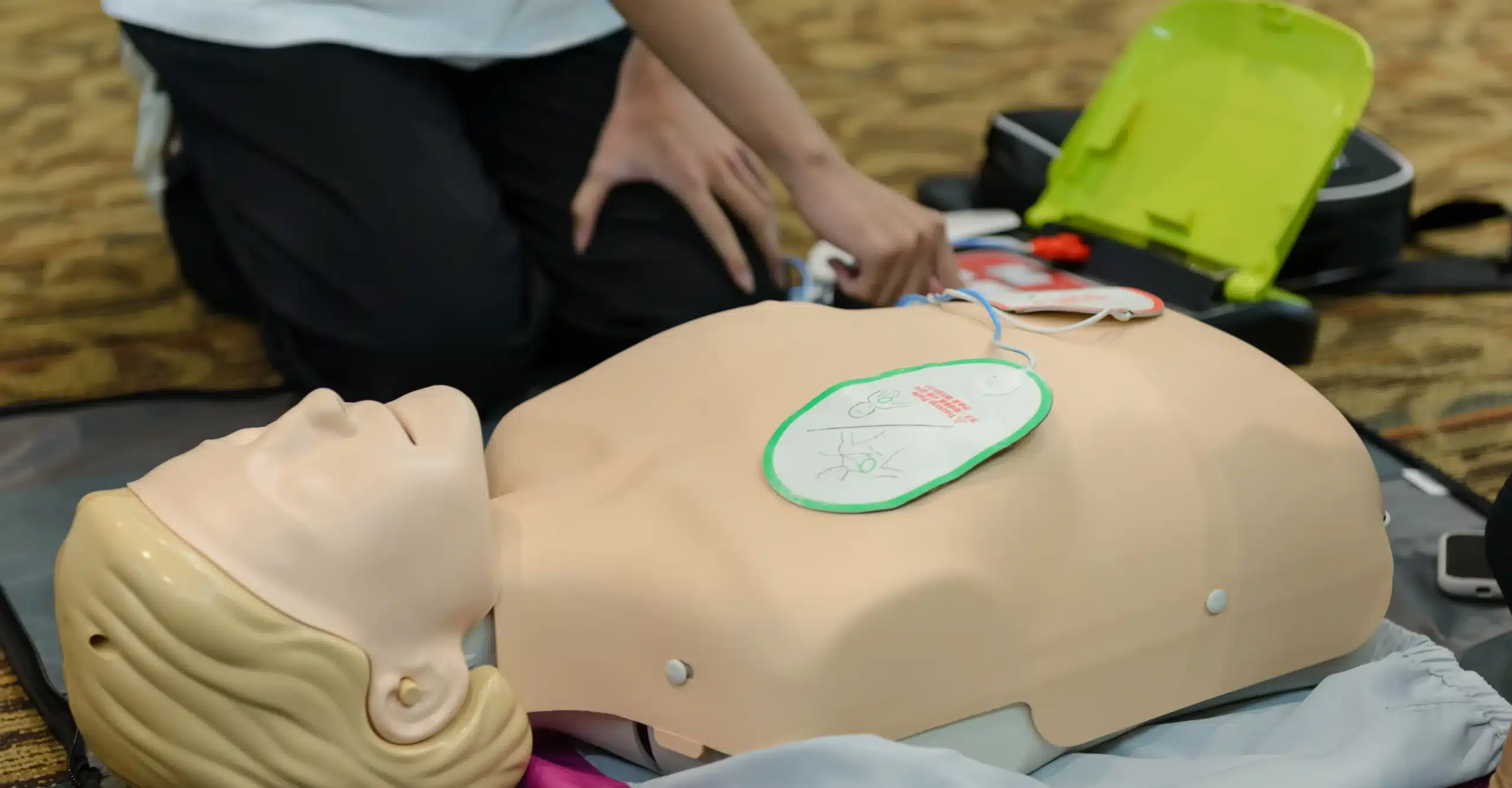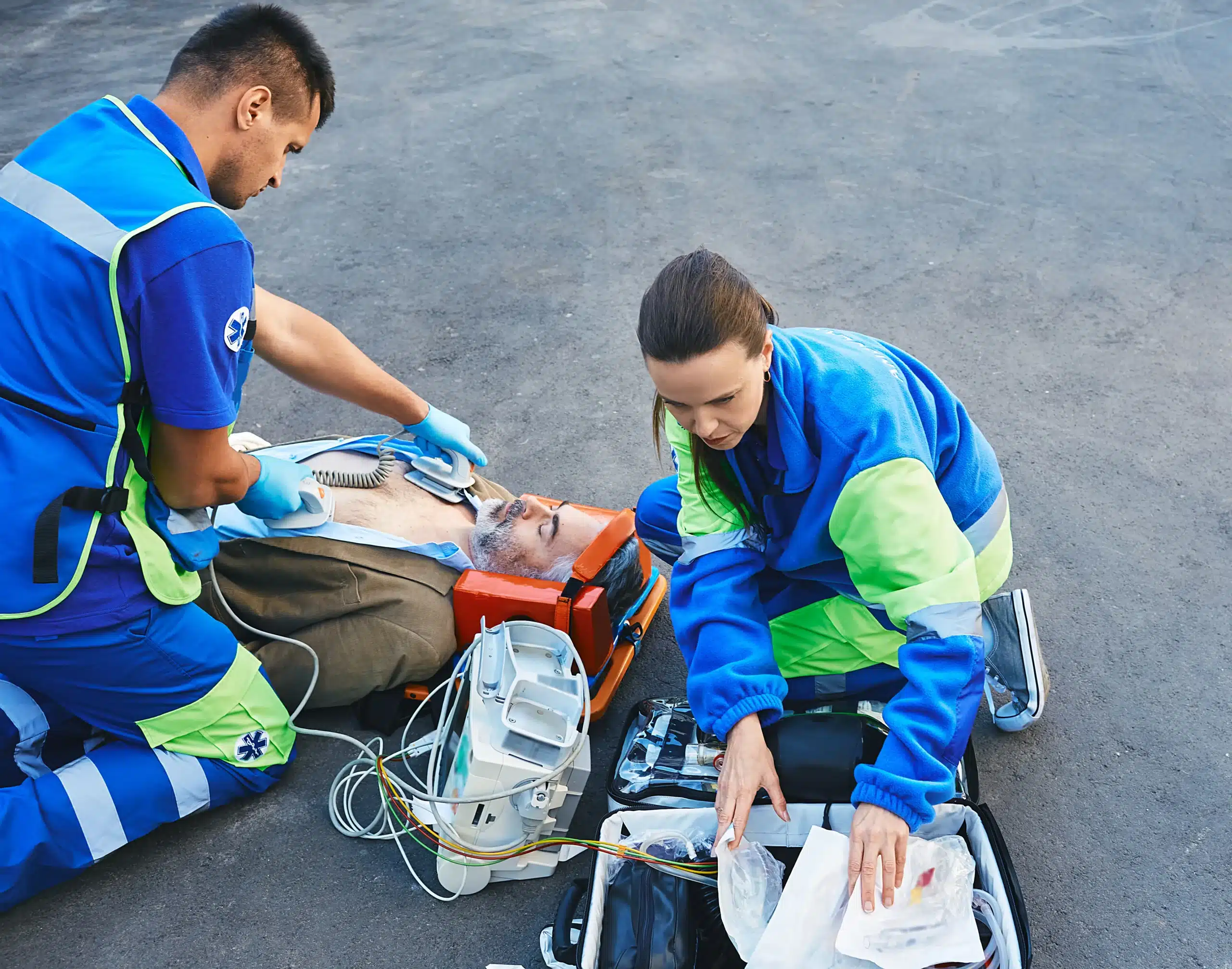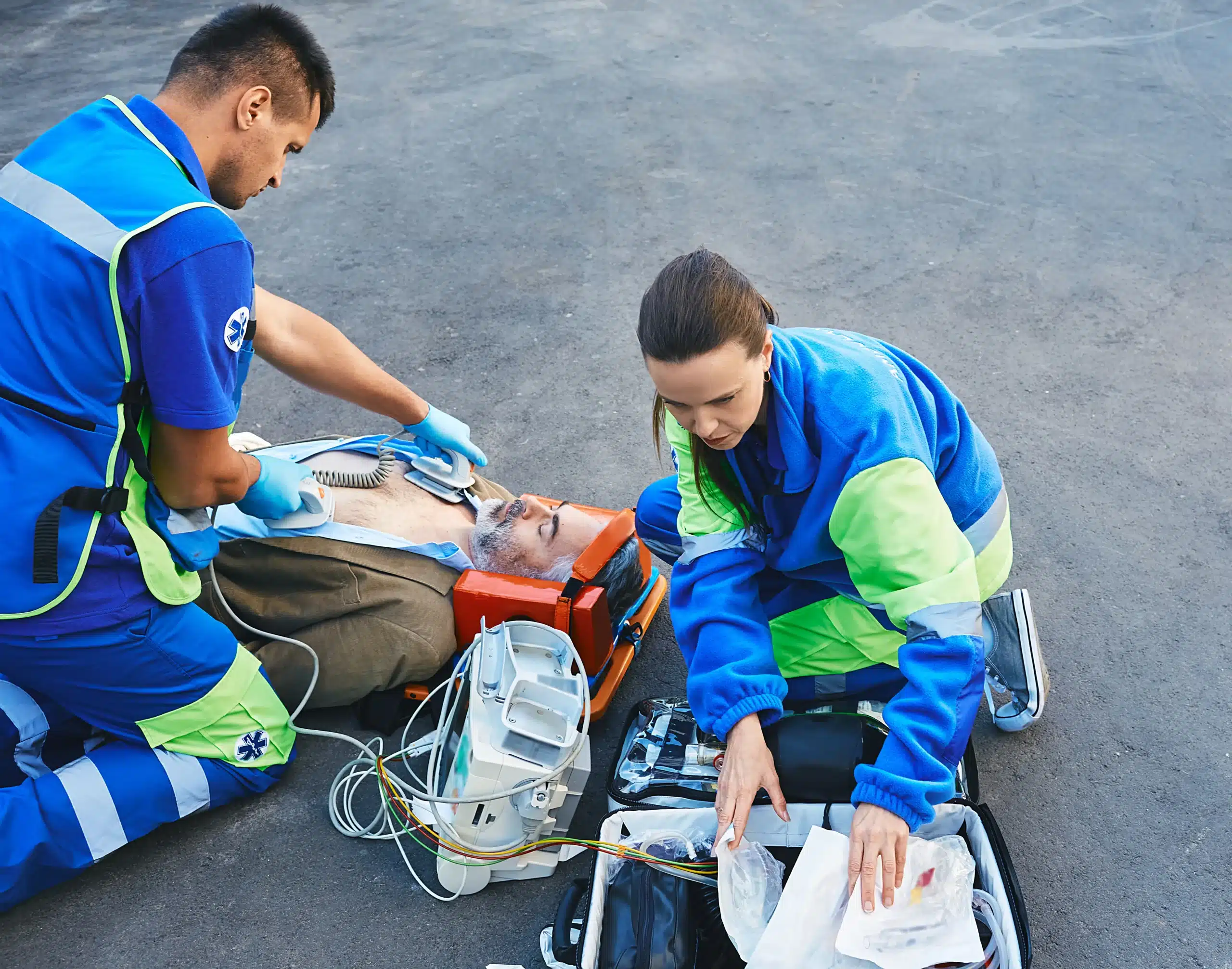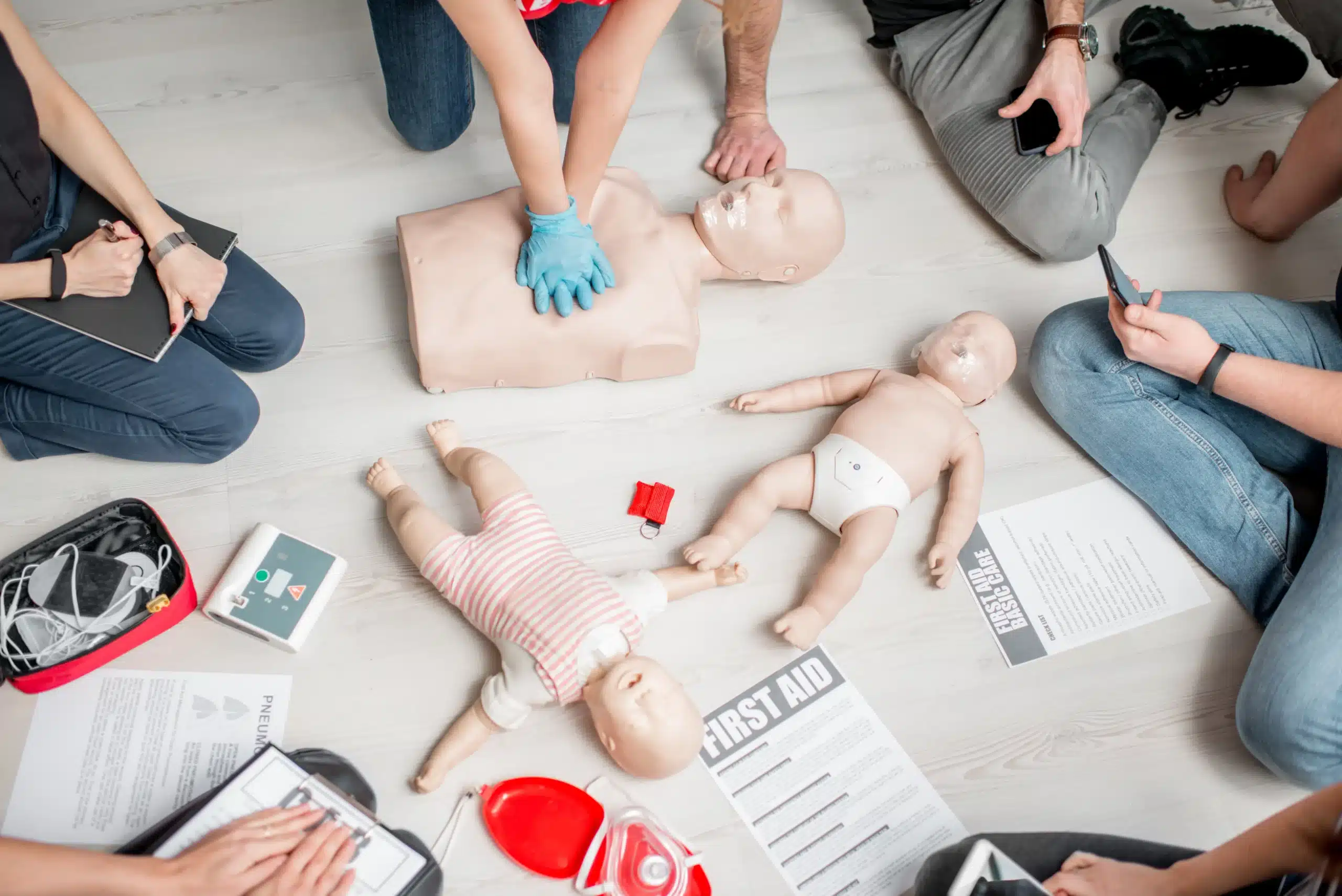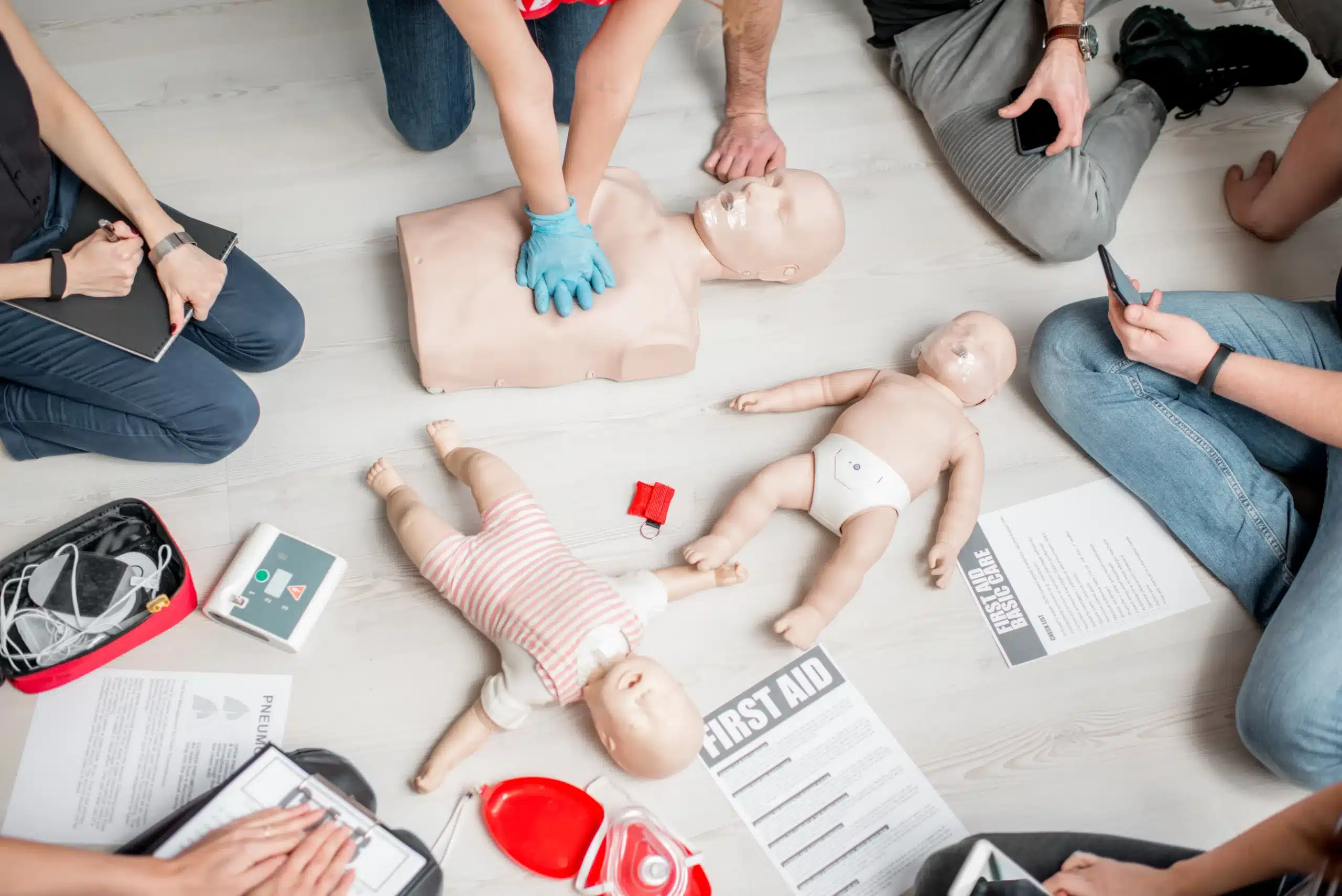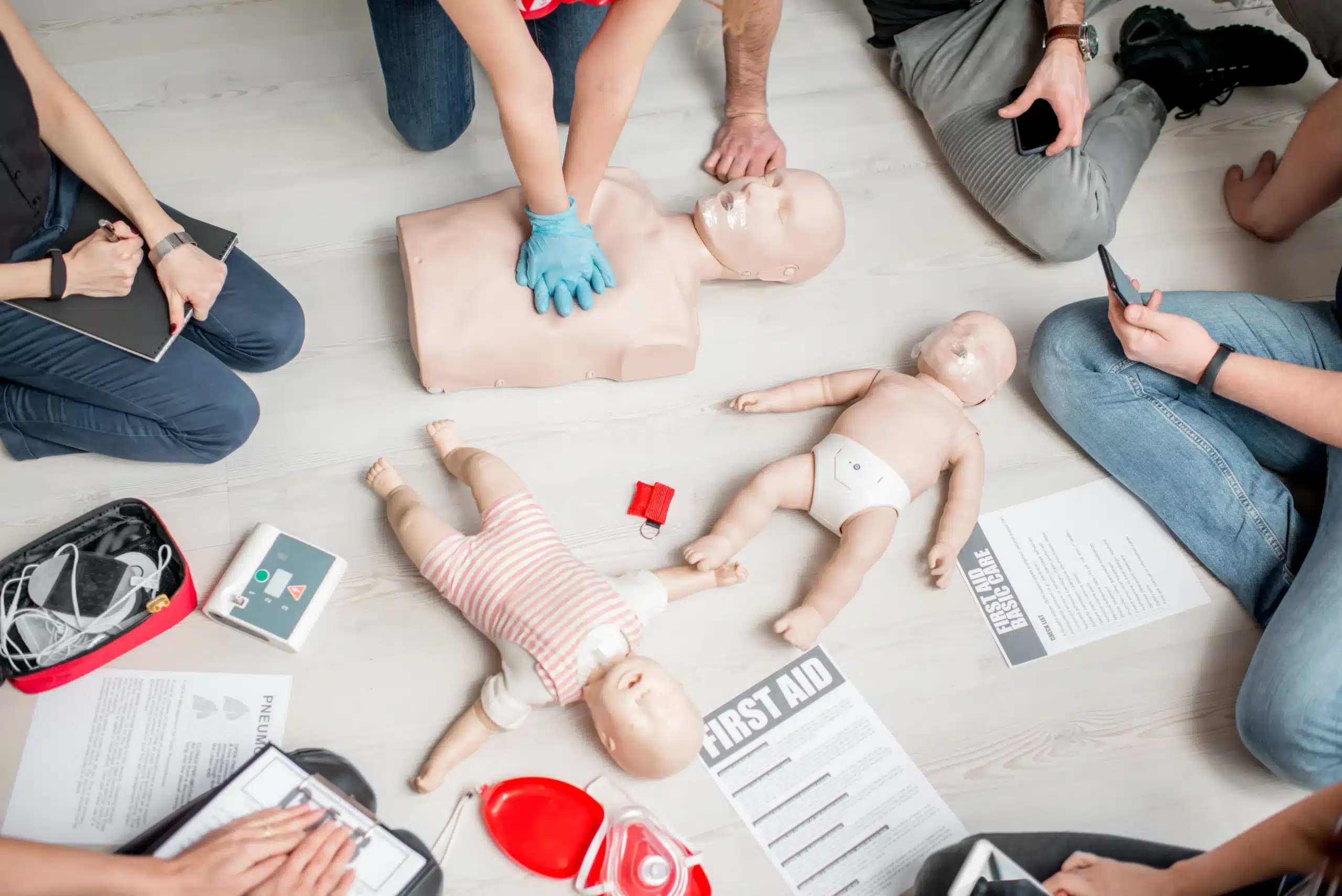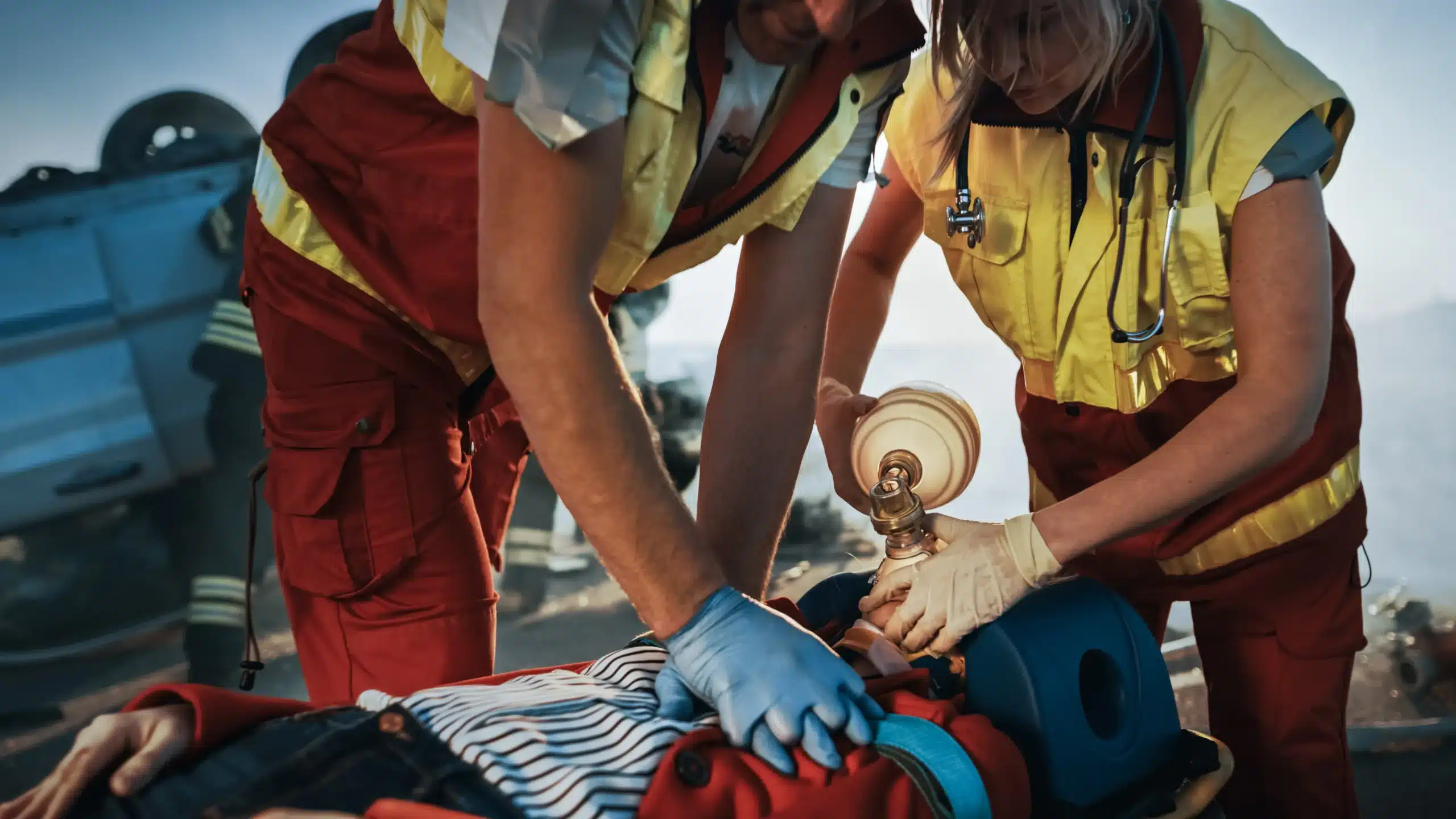Ever feel like you’d be lost in a medical emergency? Like you’d want to help but wouldn’t know how? It’s a common feeling, but one you can absolutely change. Basic Life Support (BLS) certification empowers you to confidently handle crises like cardiac arrest and choking. It’s more than just CPR—it’s a comprehensive toolkit of life-saving skills. Whether you’re a healthcare professional or simply want to be prepared for anything, BLS training can make a world of difference. This article breaks down everything you need to know about BLS certification, from what it is and why it matters to where to find a “BLS certification near me.” We’ll explore the skills you’ll gain, the different course formats available, and how BLS certification can benefit both your career and your peace of mind.
Key Takeaways
- BLS certification empowers you to save lives: It provides essential skills for handling medical emergencies, from cardiac arrest to choking, applicable in professional healthcare settings and everyday life.
- Choose the right BLS course for your needs: Consider factors like accreditation, instructor qualifications, and course format (in-person, blended, or online) to ensure a high-quality learning experience.
- Stay current with BLS best practices: Renew your certification every two years and seek continuing education opportunities to maintain your skills and knowledge of the latest life-saving techniques.
What is BLS Certification?
Definition and Purpose
Basic Life Support (BLS) certification equips healthcare providers and first responders with the skills to handle life-threatening emergencies. It’s a critical credential for professionals like doctors, nurses, EMTs, and other healthcare workers. BLS goes beyond standard CPR training by encompassing a broader range of life-saving techniques. Think of it as your toolkit for responding to cardiac arrest, breathing emergencies, and choking. BLS ensures you can confidently step in during those crucial moments when seconds count. The goal is to stabilize the patient until more advanced medical help arrives. This often involves performing CPR, using an AED, and clearing obstructed airways. It’s about providing immediate care that can dramatically improve a person’s chances of survival. For a deeper dive into the distinctions between BLS and CPR, the Red Cross offers a helpful comparison. At Safety Training Seminars, we offer American Heart Association BLS certification to help you gain these essential skills.
Skills Learned in BLS Training
BLS training provides a comprehensive skill set essential for anyone involved in emergency medical response. You’ll learn more than just CPR—the curriculum covers using an Automated External Defibrillator (AED), administering first aid, and making quick, informed decisions under pressure. The training also emphasizes maintaining a safe environment during an emergency, working effectively as a team, and understanding the legal aspects of providing aid. These skills empower you to act decisively and efficiently in high-stakes situations. BLS certification courses build critical thinking skills, preparing you to assess a situation, prioritize actions, and deliver the most effective care possible. This comprehensive approach ensures you’re well-prepared to handle a wide range of medical emergencies. You can find more information on our BLS training page.
Why Get BLS Certified?
BLS certification shows you’re prepared to handle medical emergencies. Whether you work in healthcare or not, knowing BLS can make a difference in critical situations. It prepares you to respond effectively and possibly save a life.
Importance for Healthcare Professionals
Healthcare providers, like doctors, nurses, and EMTs, often need BLS certification for their jobs. It confirms you have the skills to manage emergencies like cardiac arrest, breathing problems, and blocked airways. BLS builds on the basics of CPR, adding advanced techniques essential for professional rescuers. This specialized training prepares you to deliver better care in crises, working with a team and using medical equipment. BLS certification is usually good for two years, and renewal courses are easy to find so you can keep your skills current. If you are a healthcare provider in or near Walnut Creek, check out our BLS certification courses.
Benefits for Everyone
Even outside healthcare, knowing BLS is incredibly helpful. Cardiac arrests can happen anywhere, at any time. More than half a million happen every year in the US. BLS training gives you the confidence to respond and potentially save someone’s life. Even if your certification has expired, some training is better than none. In a crisis, those skills, even if they’re a little rusty, can still be helpful. The focus on practical training means you’ll gain the confidence to act quickly and effectively in emergencies. Safety Training Seminars offers BLS certification in Walnut Creek at an affordable price.
Find BLS Certification Courses Near You
Finding the right BLS certification course means understanding your options. Let’s explore a few avenues you can take.
Safety Training Seminars in Walnut Creek
If you’re in the Walnut Creek, Concord, or Pleasant Hill area of California, Safety Training Seminars offers a range of BLS certification courses as an American Heart Association Training Center. They have several options, including the RQI program for convenient skills verification and recertification. With a low price guarantee and customer support, they prioritize accessible, high-quality training. Visit their website for course schedules and details.
Other Local Training Centers
Organizations like the American Red Cross also offer BLS certification courses, often with both in-person and blended learning options (online instruction combined with in-person skills sessions). The Red Cross uses experienced instructors and a curriculum reviewed by their Scientific Advisory Council, incorporating real-world scenarios and sometimes customizing training to include local protocols. You can find Red Cross courses on their website. Hospitals and community colleges also frequently offer BLS training—check their websites or contact them directly.
Online Course Options
Online BLS courses are excellent for flexibility. The American Red Cross, for instance, has a blended learning BLS program that combines online coursework with in-person skills practice. The online portion uses interactive modules, letting you learn at your own pace. The system adapts to your skill level, which can shorten the total time needed. This format works well for busy schedules or independent learners. Remember that while the online portion is flexible, the in-person skills sessions are critical for practicing and demonstrating essential BLS techniques.
BLS Certification Course Formats
Choosing the right BLS course format depends on your learning style, schedule, and comfort level with technology. Let’s break down the most common options: in-person, blended learning, and online courses.
In-Person Classes
In-person BLS classes offer a traditional learning environment with direct interaction with a certified instructor. This format is ideal for people who value hands-on learning and thrive in a classroom setting. You’ll get real-time feedback on your CPR technique, AED use, and other essential skills. Plus, the face-to-face interaction allows you to ask questions and get clarification immediately. Our in-person BLS courses at Safety Training Seminars emphasize this hands-on training and provide the immediate feedback you need to master these lifesaving skills. We serve Walnut Creek, Concord, and Pleasant Hill, CA.
Blended Learning
Blended learning combines online learning with in-person skills practice. This approach offers flexibility for busy schedules. You’ll complete the cognitive portion of the course online at your own pace, covering topics like the BLS chain of survival and recognizing life-threatening emergencies. Then, you’ll attend a shorter, in-person session to practice your skills and demonstrate competency to a certified instructor. This format gives you the best of both worlds—the convenience of online learning and the reinforcement of hands-on practice. If this sounds like a good fit, the American Red Cross offers blended learning BLS courses.
Online Courses
Fully online BLS courses offer maximum flexibility. You’ll complete all coursework online, including videos, interactive exercises, and assessments. While convenient, it’s important to note that fully online courses typically require a separate in-person skills check to receive your BLS certification. This means you’ll need to find a certified instructor to evaluate your skills after completing the online portion. The American Red Cross also provides fully online BLS courses if you prefer a completely self-paced learning experience. They can also connect you with local instructors for your in-person skills evaluation.
BLS Certification: Cost vs. Value
Getting BLS certified is an investment in your skills and ability to respond to emergencies. But how much does it cost, and what factors influence the price? Let’s break down the typical costs associated with BLS certification and explore the value it brings.
Typical Price Range
BLS certification costs vary. Generally, you can expect to pay between $30 and $150 per person. Location plays a role, as prices can differ regionally.
Factors Affecting Cost
Several factors influence how much you’ll pay for BLS certification. Training providers set their own fees, so prices will differ between organizations. The course format also matters. In-person training often costs more than online courses because of the resources involved, like classroom space and equipment. Finally, your current certification status matters. If your certification has lapsed, you might need to retake the full course instead of a shorter recertification course, which is typically more affordable.
Safety Training Seminars’ Low Price Guarantee
At Safety Training Seminars, we believe that high-quality BLS training should be accessible to everyone. We offer competitive pricing and a low-price guarantee. Check out our BLS certification course to learn more about our pricing and how we can help you gain this essential skill without breaking the bank. We’re committed to providing affordable, high-quality training to empower you to save lives.
What to Expect in a BLS Course
So, you’re ready to become BLS certified? Great! Here’s a rundown of what you can expect, from course structure to key topics covered. We’ll also look at the hands-on practice and assessment involved in getting certified.
Course Duration and Structure
BLS certification courses typically involve a combination of online learning and in-person skills sessions. This blended learning approach allows you to study the theoretical aspects of BLS at your own pace online, then practice those skills in a real-world setting with a certified instructor. Expect the in-person portion to last several hours, depending on the specific course and provider. Renewal courses, for those recertifying, are often shorter and may focus primarily on skills practice and updates. Safety Training Seminars offers various course formats to fit your schedule.
Key Topics Covered
A BLS course covers a wide range of life-saving techniques and essential knowledge. You’ll learn adult, child, and infant CPR, how to use an automated external defibrillator (AED), and relief of choking. Beyond these core skills, the course also emphasizes the importance of scene safety, critical thinking under pressure, effective teamwork during emergencies, and the legal aspects of providing care.
Hands-On Practice
The hands-on portion of the course is where you’ll put your knowledge into action. You’ll work with an instructor and other students to practice CPR techniques on mannequins, learn how to operate an AED, and rehearse responses to various emergency scenarios. This practical experience is crucial for building confidence and ensuring you’re prepared to respond effectively in a real emergency. At Safety Training Seminars, we prioritize hands-on training to ensure you feel comfortable and confident in your skills.
Assessment and Certification
To receive your BLS certification, you’ll need to demonstrate competency in both the online and in-person components of the course. This typically involves passing a written exam and successfully completing a skills test with your instructor. Upon successful completion, you’ll receive your BLS certification, which is typically valid for two years. Remember to check with your certifying organization or employer for specific renewal requirements as you approach your expiration date. Many providers, including Safety Training Seminars, offer streamlined renewal courses to help you maintain your certification.
Choose the Right BLS Provider
Finding the right BLS course isn’t just about location—it’s about quality training that fits your needs. Here’s what to consider:
Accreditation and Recognition
Look for BLS certification accredited by a nationally recognized organization like the American Heart Association. This accreditation validates the training’s quality and ensures it meets industry standards. ACLS.com notes their online BLS certification is accredited by organizations like the American Dental Association (ADA) and the American Medical Association (AMA), ensuring wide acceptance. Check for similar accreditations from your chosen provider.
Instructor Qualifications
Experienced, certified instructors are essential for effective BLS training. They should have deep knowledge and be able to demonstrate techniques clearly. The Red Cross emphasizes their instructors’ experience and curriculum review by their Scientific Advisory Council. Inquire about instructor credentials when researching providers.
Course Flexibility and Support
Consider your schedule and learning style. Do you prefer in-person, blended learning, or a fully online course? The Red Cross offers blended learning, combining online coursework with in-person skills sessions. This offers flexibility while maintaining hands-on practice. Think about the support offered too. Are there refresher materials or practice opportunities after the course? The Red Cross online portion uses interactive modules that adapt to your skill level, potentially saving you time. These factors can significantly impact your learning.
Maintain Your BLS Certification
Keeping your BLS skills sharp is crucial for providing effective care in emergencies. This section covers how to maintain your certification and stay up-to-date with the latest life-saving practices.
Renewal Requirements
BLS certification is typically valid for two years. To maintain your credentials and ensure your skills are current, you’ll need to renew your certification before it expires. Keep an eye on your certification card for the expiration date. Recertification courses are readily available, often offered by the same organizations that provided your initial training. Start looking into recertification options a few months before your certification lapses to avoid any gaps in your qualification.
Continuing Education
Even within the two-year certification period, staying informed about updates in BLS guidelines is essential. The science behind resuscitation and emergency care is constantly evolving. Ongoing learning is key to delivering the most effective care. Many organizations offer continuing education opportunities, such as online modules and refresher courses. These resources can reinforce your existing knowledge and introduce you to any new techniques. The Red Cross provides various online resources and blended learning options that can fit into your schedule and keep you at the forefront of BLS best practices. Taking advantage of these opportunities demonstrates your commitment to providing high-quality care and ensures you’re always prepared to respond confidently in an emergency.
Top BLS Certification Providers
Finding the right BLS certification provider is key to receiving high-quality training. Here’s a rundown of some reputable organizations and what they offer:
Safety Training Seminars
Safety Training Seminars is a woman-owned American Heart Association Training Center, dedicated to providing top-notch BLS, ACLS, PALS, CPR, and First-aid courses across various California locations. We’re proud to offer the AHA’s RQI program, a modern and efficient path to BLS certification for healthcare professionals. With classes offered every day of the week, we make it easy to fit training into your busy schedule. Our commitment to affordable pricing makes high-quality training accessible to everyone. We serve Walnut Creek, Concord, and Pleasant Hill, CA.
American Heart Association
The American Heart Association (AHA) sets the standard for BLS training. Their courses equip healthcare professionals with the skills and knowledge needed for emergency situations. The AHA’s RQI program is particularly well-regarded for its modern approach, ensuring participants receive the most up-to-date training.
American Red Cross
The American Red Cross is widely recognized for its comprehensive training programs, including BLS certification. They offer various courses tailored to different audiences, from healthcare providers to the general public. The Red Cross emphasizes hands-on training and real-life scenarios to prepare participants for emergencies.
National CPR Foundation
The National CPR Foundation offers a range of CPR and BLS certification courses accessible both online and in person. Their programs cater to both healthcare professionals and the general public, ensuring widespread access to these essential skills.
ProTrainings
ProTrainings provides online and blended learning options for BLS certification, a convenient choice for busy professionals. Their courses are designed to be engaging and informative, focusing on practical skills applicable in real-world situations.
Health & Safety Institute (HSI)
The Health & Safety Institute (HSI) offers a variety of training programs, including BLS certification. They prioritize high-quality training that meets the needs of healthcare professionals and organizations. HSI’s courses are designed for flexibility and accessibility, allowing participants to learn at their own pace.
Common BLS Certification Questions
Thinking about getting BLS certified? You probably have some questions. Here are a few we hear often at Safety Training Seminars:
- Is BLS the same as CPR certification?
While BLS includes CPR, it’s more comprehensive. Think of BLS as the next level up, especially for healthcare providers and first responders. It covers CPR, of course, but also other life-saving techniques for situations like cardiac arrest, breathing emergencies, and choking. CPR training focuses primarily on rescue breaths and chest compressions for different age groups. BLS builds upon this, adding advanced airway management and other team-based resuscitation skills. If you’re pursuing a career in healthcare, BLS certification is usually required.
- How do I get BLS certified?
You’ll need to complete a BLS course through an accredited training provider like Safety Training Seminars or the American Red Cross. These courses combine classroom instruction with hands-on practice and a skills test. This blended approach ensures you understand the material and can perform the techniques correctly under pressure.
- Is online BLS certification legitimate?
Yes, if you choose an accredited provider. Many reputable organizations offer online BLS certification that’s widely accepted. However, it’s crucial to verify the provider’s legitimacy and ensure their certification meets your workplace requirements. Online BLS courses often offer a convenient way to learn the material at your own pace, but they typically require an in-person skills assessment component.
- Is there a difference between BLS for healthcare providers and other BLS courses?
Yes, BLS for Healthcare Providers is specifically designed for individuals working in healthcare settings. It emphasizes team dynamics and advanced life support techniques relevant to professional medical environments. Other BLS courses, like those for the general public, focus on essential life-saving skills for individuals to use in their daily lives. Make sure you choose the right BLS course based on your specific needs and career goals. If you’re unsure, contact us at Safety Training Seminars, and we can help you find the perfect fit.
Related Articles
- BLS Certification in Pleasant Hill: A Complete Guide
- BLS Courses in Concord: Find the Right Class for You – Walnut Creek CPR Classes
- CPR Training in Pleasant Hill: Your Complete Guide – Walnut Creek CPR Classes
- BLS Courses in Walnut Creek: A Complete Guide
- BLS Classes Near Me: Your Ultimate Guide – Walnut Creek CPR Classes
Frequently Asked Questions
What’s the difference between BLS and CPR? BLS (Basic Life Support) certification is more comprehensive than CPR. It includes CPR but goes further, covering a broader range of life-saving skills for various emergencies like choking and breathing difficulties. BLS also emphasizes teamwork and the use of equipment like AEDs, making it essential for healthcare providers. CPR training focuses primarily on chest compressions and rescue breaths.
How long does BLS certification last, and how do I renew it? BLS certification is typically valid for two years. You’ll need to take a recertification course before it expires to keep your skills current and maintain your credentials. Check with your certifying organization or employer for specific renewal requirements. Many providers offer streamlined renewal courses that focus on refreshing essential skills and updating you on any changes in guidelines.
What if my BLS certification has expired? If your BLS certification has lapsed, you’ll likely need to retake the full course rather than a shorter renewal course. While some knowledge retention is expected, retaking the course ensures you’re up-to-date on the latest guidelines and best practices. It also allows you to refresh essential skills and regain confidence in your ability to respond effectively in an emergency.
What does a BLS course typically cost? The cost of BLS certification varies depending on the training provider, location, and course format (in-person, blended, or online). Generally, expect to pay somewhere between $75 and $150. Some providers, like Safety Training Seminars, offer a low-price guarantee, so it’s always a good idea to compare prices and look for the best value.
How can I find BLS classes near me? Several organizations offer BLS classes, including the American Red Cross, the American Heart Association, and local hospitals and community colleges. You can also find training centers like Safety Training Seminars that specialize in BLS and other life-saving certifications. Online searches and checking with local healthcare facilities are good starting points. Make sure to choose a provider accredited by a nationally recognized organization to ensure the quality of your training.
